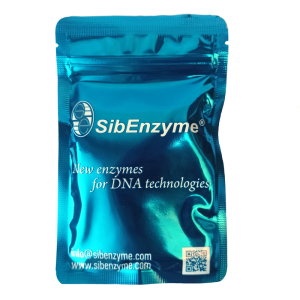Description
Recognition site and hydrolysis position:
| ATTAAT | AT↑TAAT |
| TAATTA | TAAT↓TA |
Source: An E.coli strain, that carries the cloned gene VspI from Vibrio species 343
Unit definition:
One unit of the enzyme is the amount required to hydrolyze 1 μg of Lambda DNA in 1 hour at 37°C in a total reaction volume of 50 μl.
Assayed on:
Lambda DNA
Optimal SE-buffer: SE-buffer W
Enzyme activity (%):
| B | G | O | W | Y | ROSE |
| 0 | 10 | 50 | 100 | 25 | 50 |
Storage conditions: 10 mM Tris-HCl (pH 7.6); 50 mM NaCl; 0.1 mM EDTA; 1 mM DTT; 200 μg/ml BSA; 50% glycerol. Store at -20°C.
Ligations:
After 10-fold overdigestion with enzyme 70% of the DNA fragments can be ligated.Of these, 90% can be recut. In the presence of 10% PEG ligation is better.
Non-specific hydrolisis:
No nonspecific activity was detected after incubation of 1 μg of Lambda DNA with 10 u.a. of enzyme for 16 hours at 37°CReagents Supplied with Enzyme
10 X SE-buffer W
Reagents Supplied with Enzyme:
Methylation sensitivity: Blocked by ATTAmAT methylation.
Notes:
References:
Degtyarev, S.Kh., Repin, V.E., Rechkunova, N.I., Tchigikov, V.E., Malygin, E.G., Mikhajlov, V.V., Rasskazov, V.A. Bioorg. Khim. 13: 420-421 (1987).
V.A. Chernukhin, M.A. Abdurashitov, V.N. Tomilov, D.A. Gonchar, S.Kh. Degtyarev Comparative restriction enzymes analysis of rat chromosomal DNA in vitro and in silico // Translated from “Ovchinnikov bulletin of biotechnology and physical and chemical biology” V.2, No 3, pp 39-46, 2006



